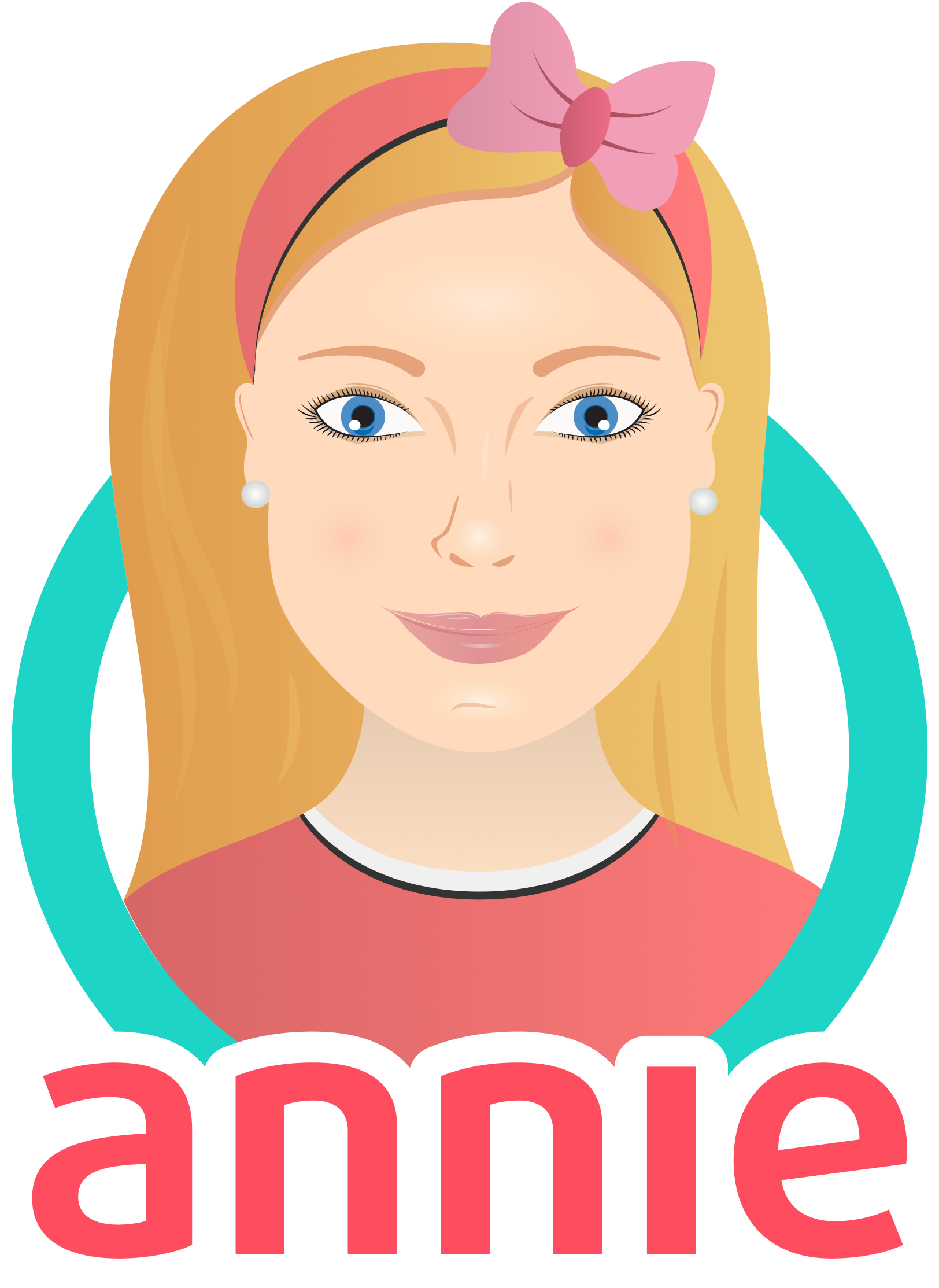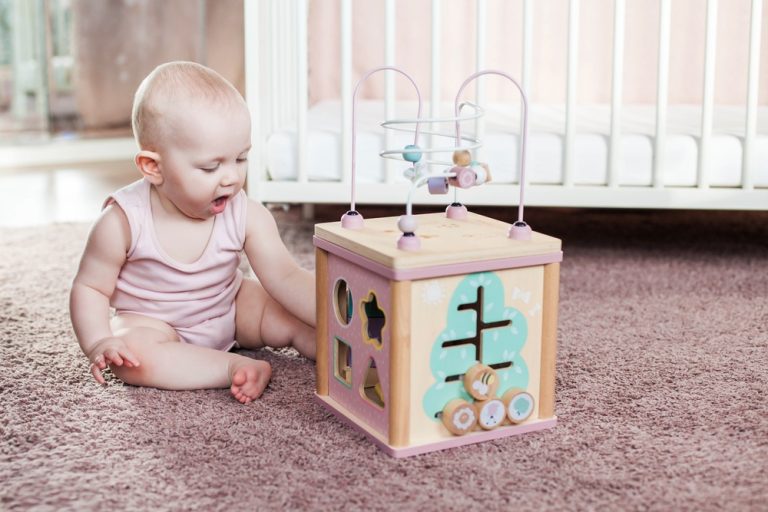
Games for Babies
- Created:
24. 8. 2021 - Updated:
11. 12. 2023
In the first year of a baby‘s life, the child goes through the most complex and fastest development in all aspects. It is therefore advisable for parents to know how to stimulate their baby appropriately in order to develop healthily and contentedly.
Fun baby games that can boost your child’s skills and development don’t need to be complicated. In fact, they shouldn’t be. You may even find that many of the best games you can play with your child to help them learn about the world around them are what you already do naturally.
0 to 1st Month of the Baby’s Life
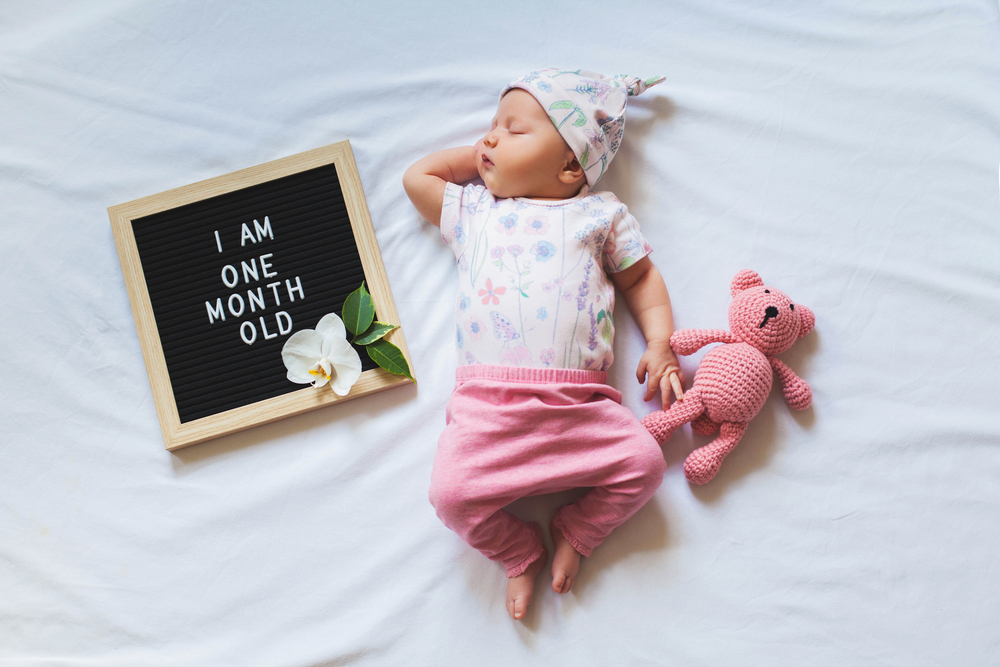
Baby in the Mirror
Newborns love to examine their reflection and keep looking at themselves over and over without being bored. You can also put the mirror in the baby crib, but it must be unbreakable.
Hanging Toys
Choose a very colorful version with strong contrasts. If it hangs over the crib, make sure it is out of reach of the baby so that the carousel does not fall at the baby.
Music
Like adults, children like to listen to music. When the baby is awake, you can play the music louder, but mute it as soon as the baby becomes grumpy or sleepy. Also watch the baby, because it may happen that some style of music will bother him. You can also dance to the music with your child – you learn the baby to perceive rhythm.
2nd Month of Baby’s Life
It is very important for the child to learn to control the movements of the head with his will and to be able to keep the head upright in all positions – on the back, on the abdomen, lying on the forearm.
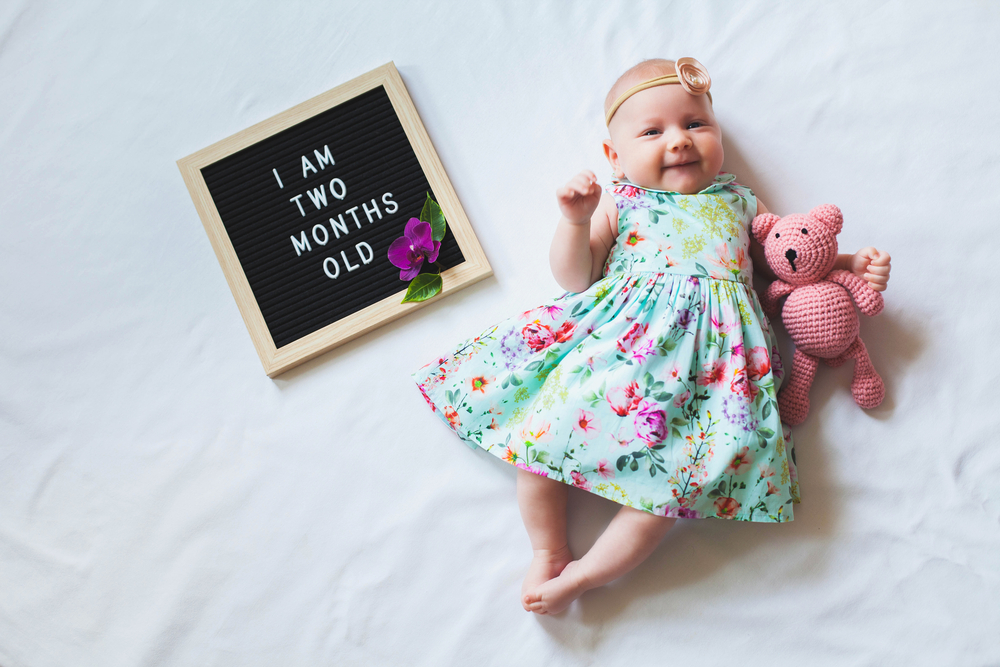
Turn the Head to the Toy
The baby lies on his back, we show him the toy and we move it over the child at a distance of about 40 cm from the face, so that he can watch it by moving his eyes and head to the right and left. Make sure that the child turns his head from the middle position – this means that if the child is in the habit of having the head turned to one side (eg to the right), we turn it to the center and lure him with a toy to turn it to the left. If the head is held to one side significantly more often, this is a reason to visit a physiotherapist.
Holding the Head
When carrying a baby, we support the head less and less. When he lies on his stomach over our forearms, we gradually extend the baby so that his head protrudes more and more over his forearm (in the 3rd month baby can hold the head by self). Make sure that the child does not tilt his head.
Grabbing Objects in Hands
We put various objects in the baby’s hands – a rattle, a string, a tube, plastic, paper, etc. We offer objects alternately in the right and left hand. It is necessary to give the baby an object so that he can easily grab it, and remember that we practice gripping and dropping the object with the baby, not long-term holding.
Game With Baby Trapeze
We hang toys on the baby trapeze at a distance of about 15 cm above the child’s chest. For a start 1-2 colorful toys are enough, put there even those that make a sound when touched. Toys should be placed that the child “accidentally” touches toys that make a sound when they move spontaneously with their hands. This attracts attention and gradually the “random movements” become intentional – the child tries to grab the toy.
3rd Month of Baby’s Life
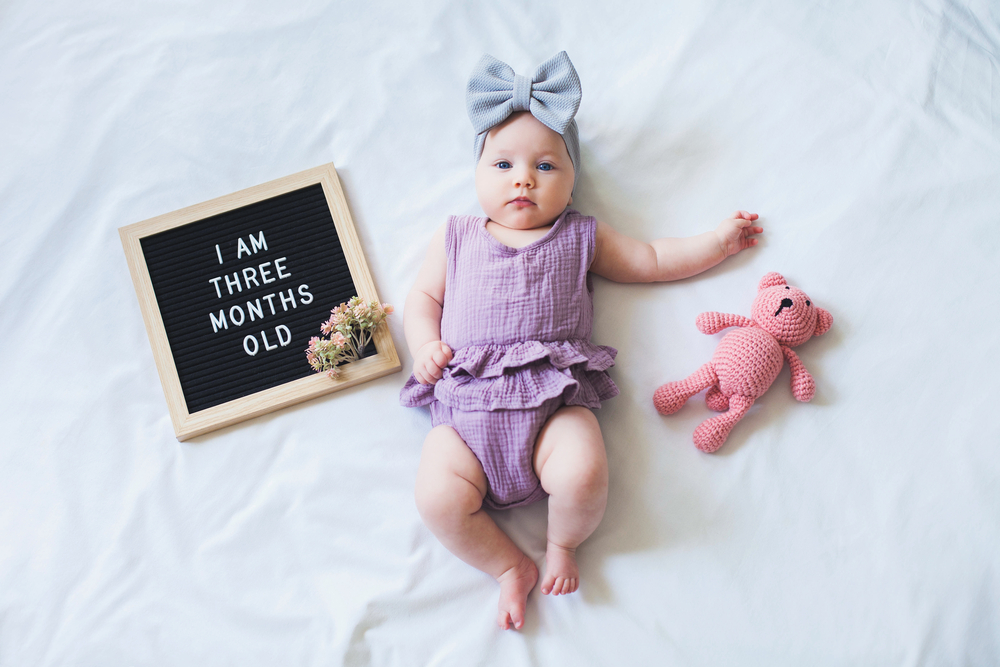
Lifting Head in Supine Position
We place the baby on the tummy and adjust its arms so that they lie bent and pressed against the chest or slightly below the chest. We turn the head face down on the mat, the baby should raise his head. Leave it on the abdomen for at least 2-3 minutes. When the baby is satisfied, we can keep him that even longer. We put the baby on the tummy as often as possible.
Important: The baby will not raise his head just to see something. That is why we attract the child with something interesting.
💡 TIP N.1: How to help the baby lift the head?
Head Movements
Hold the baby in a horizontal position so that the baby is lying on the tummy on your hand – the baby can look around better. Walk with baby like this around the apartment or outside. The baby watches his surroundings, keeping his head raised and at the same time turning it in all directions beyond what interests him. The position on the back puts baby to sleep. If the child has a tendency to tilt his head and bends in the torso, try baby massages.
Forefooting
Sit in a chair. Place the child with its buttocks on your palms so that the back of baby lies on both of your forearms. Baby’s head should be placed on your stomach. Move your palms by raising and lowering the baby’s pelvis. This simultaneously raises and lowers the child. It is important to feel that the baby is actively involved and helps to move the legs to the tummy.
💡 TIP N.2: Toys suitable for baby‘s development – For 3-Month and Older Babies
4th Month of Baby’s Life
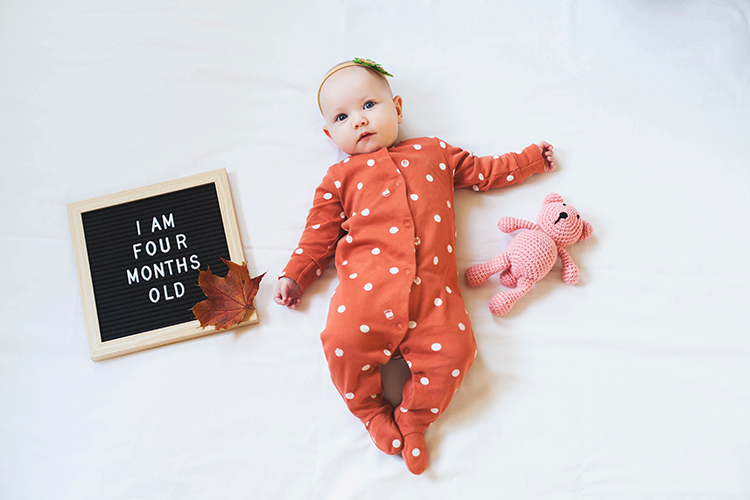
Tickling Babies
This activity must be performed gently and carefully. Baby may react very violently and the feet and hands may move feverishly. Excessive stimulation can cause agitation and crying of the baby.
Just Beyond the Reach
When baby is lying face down, place favorite toys just out of reach. If baby can already turn from one side to the other, baby will try to reach the toys. Do not switch the child’s effort too much – after a while of trying, push the toy near the baby, and later this game repeat.
Walk Talk
Walk around the room as you talking. This activity is suitable when the baby can already sit in a stable position (but never let the baby sit for a long time). The baby may sit with one of the parents while the other is walking around the room talking to the baby. This forces the baby to turn the head, which improves muscle control as well as whole body coordination and balance.
💡 TIP N.3: Between four to seven months you’ll notice your baby start being unusually cranky and wanting to bite down on everything in sight. That’s those new teeth coming in! We have collected the best baby teethers, which are designed for the little ones.
5th Month of Baby’s Life
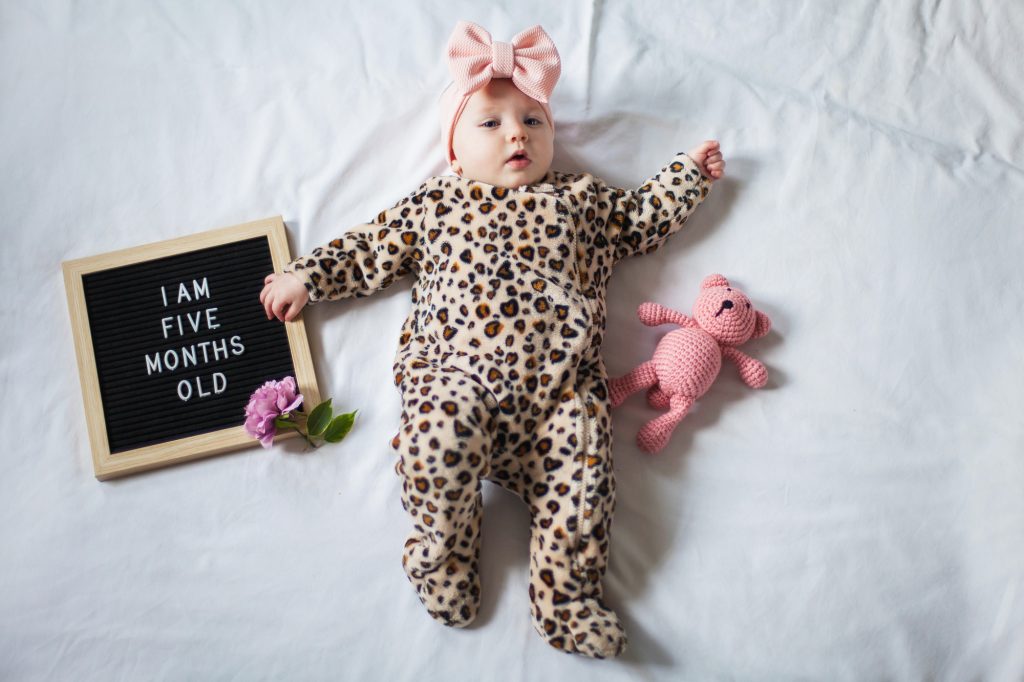
Grasping the Hand
Baby often and for a very long time plays with the hands. Baby grabs the other with one hand, touches his fingers, intertwines them.
Discovery of Own Body
As soon as the baby visually discovers his hands and later his feet, he will soon and carefully begin to touch the objects in his vicinity with his hands and feet. It is best to leave the baby without socks/naked. Each slowdown characterizes that the baby begins to control his movement.
Speech Development Games
Narration. Talk to your child, for example, about the activities you are doing together or what you plan to do today. You can gradually increase the distance between you and the baby. Then, of course, you need to raise your voice to teach the child to shout at each other.
💡 TIP N.4: When Will My Baby TALK
6th Month of Baby’s Life

Back Games
The baby should already have adopted a lying position on his back. You can support your baby with a variety of toys that can grab and hold in both hands – one toy in each hand. Except for toys and hands, the child’s own feet also become a subject worthy of baby’s interest. In this way, the baby gets to know his own body and develops motor skills. Initially, the child can reach the knees, gradually also on the feet and toes.
Table Games
Sit your baby on your knees at the table where the toys are placed. Show the child the toys to touch and examine them. Choose toys that are asymmetrical and of different sizes so that the child is forced to use both hands and also to adjust the grip and hand adjustment to the size of the object.
7th Month of a Baby’s Life
In the seventh month of baby’s life, the baby acquires movement skills of the whole body – climbing, in which the whole body is involved. Therefore, this month, focus on games that develop movement motor skills.
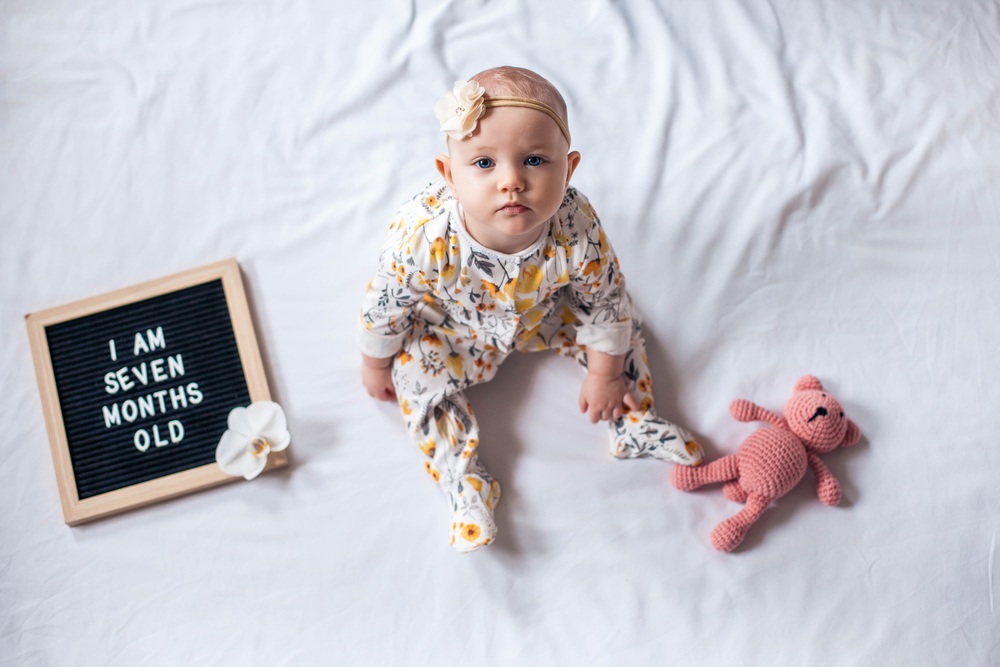
Liability Over
The parent lies on the floor on his back and places the child on his side so that baby kneels on the ground and rests his hands on parent‘s belly. On the other side parent lay a toy. The child should try to reach the toy and pushes away with his feet. The parent can help the baby by placing his palm on the child’s feet.
Obstacle Courses
Use pillows, boxes and bedding to create mini obstacle courses and encourage your child to climb between the obstacles. Become a part of the obstacle course, hide behind one of the obstacles and play peekaboo with the child.
Different Texture
Place materials with different textures on the floor – bubble wrap, soft fur rug, foam puzzles – and let the child get to know the texture by climbing from one material to another.
8th Month of Baby Life
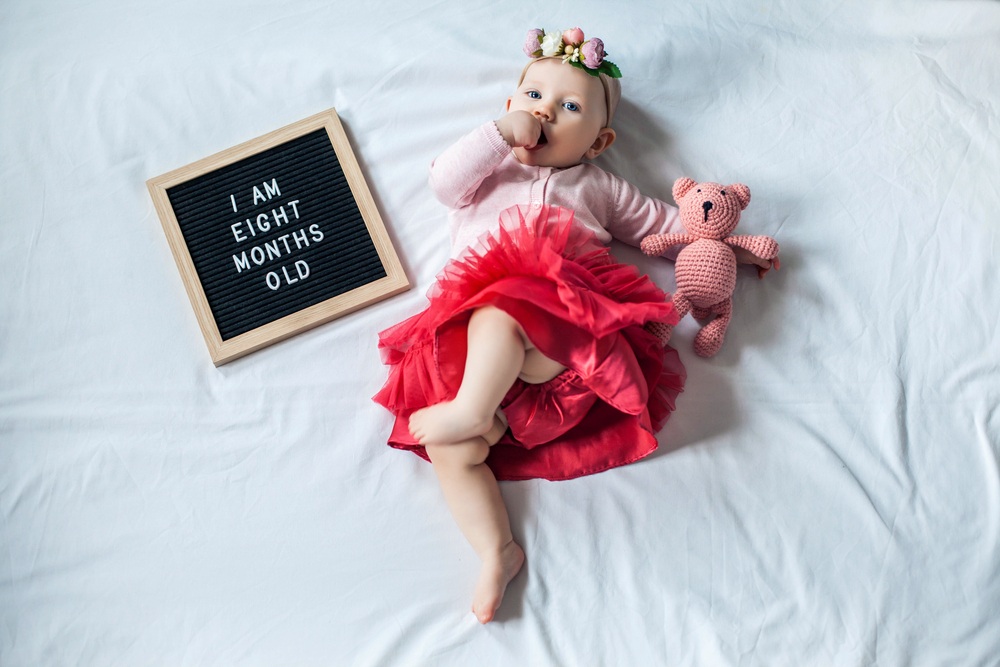
From Left to Right
The parent lies on his back on the ground and places the baby on his belly so that the baby rests on the parent’s belly with both palms. The baby’s legs are supposed to hug the parent’s waist – so the baby lies astride. To the right and left of the parent’s side, we place toys. The baby souhld try to get both toys.
Climbing the Plane
When a child learns to climb on flat ground, give the baby the opportunity to climb on a flat surface, but in trousers on the carpet, parquet, sand, grass, shallow water, etc. We make sure that the baby can‘t injure and that the surface on which it climbs is as clean as possible. Don’t forget to wash your baby’s hands before he put them in his mouth.
Chase Game
By the 10th month of the baby’s age, the baby should learn to climb in different directions: forward, backward, right, left, turn, etc. This game can help him with this a lot. The parent climbs behind the child and shouts at him jokingly “I’ll catch you”. The child’s task is to escape by climbing fast in various directions. The game develops not only the motor but also the social skills of the baby. Pay attention to the child’s behavior – if he does not laugh then he clearly does not like this game.
9th Month of Baby’s Life
This month of the baby’s life you should focus on practicing standing up and standing on feet. The goal of these games is not to teach the child to stand but to stand up. They are suitable for children who do not have problems with joints.
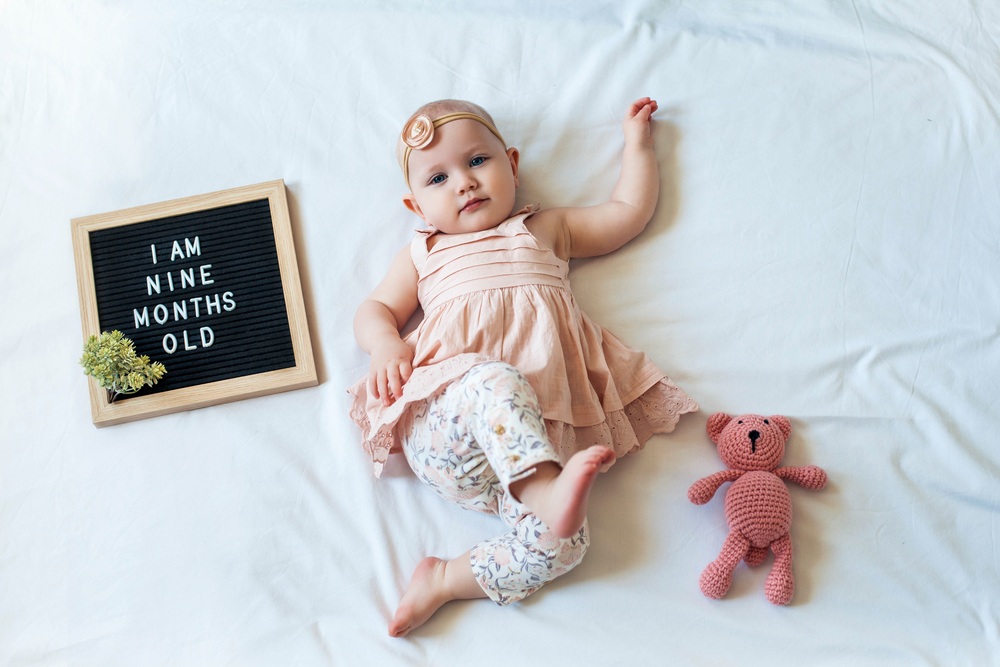
Stand Upright
Stand in front of the mirror and hold the baby so that he can see his reflection in the mirror – back to your belly. Hold baby by the taut thighs facing outwards and support the pelvis and legs with your body. The baby should lean his butt on your belly.
Stretching
Sit on the ground on your heels. Place the baby on your thighs so that baby‘s hands touch the ground. The baby’s legs are spread and lie freely to the right and left around your hips. Put your hands around the child’s thighs above the knees. Turn the bare and stretched knees of the child out so that baby‘s fingers point outwards. The child rests on his outstretched arms and raises his head. This stretches baby‘s back, hips and legs.
Climbing
Children at first come down the steps, benches, couches, etc.with his head first, and are in danger. Baby often crawl on the couch, do not stop at the edge and fall down. Therefore, it is necessary to teach the child to stop at the edge, turn around and get their feet down first. Put the baby on the sofa on his stomach so that his legs hang down. Push him gradually from the couch by pressing on the shoulders until baby slides down to a standing position – the assumption is that the baby can already stand on its own. Repeat the exercise several times. When sliding down, help your baby less and less, but be careful not to fall or injure. Watch the child’s behavior again, if he is grumpy, he doesn’t like the game and it’s time to take a break.
10th Month of a Baby’s Life
You play with your baby the games we have introduced to you in the past: handcuffing over, obstacle courses, various textures, chasing, standing upright, etc.
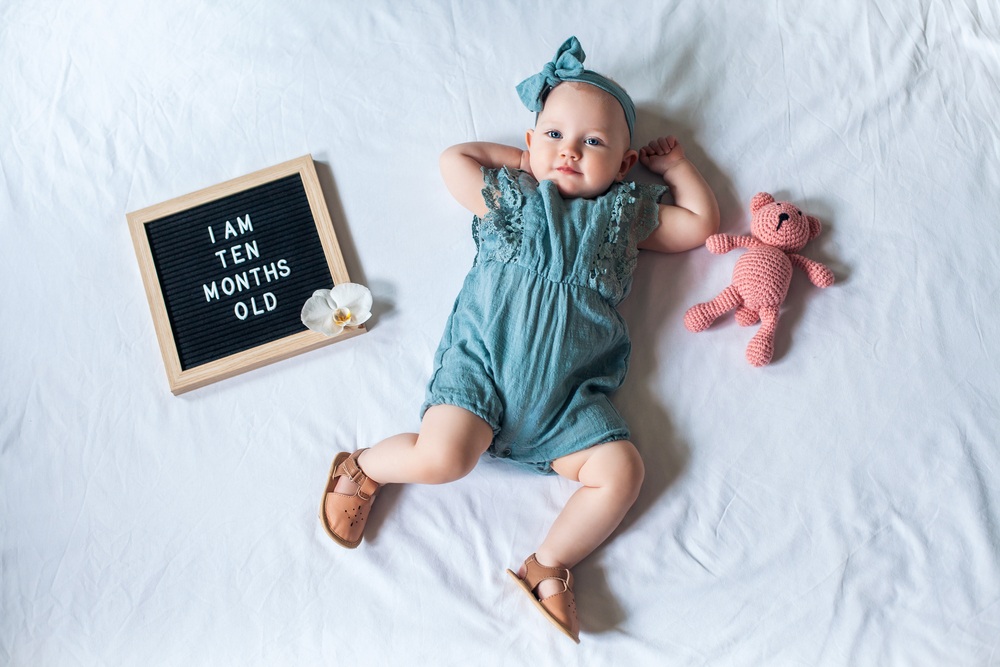
Standing up From Sitting
Choose a wide object – a mattress or a staircase. Place the child facing the mattress, then turn him around, take his hands and push him lightly to sit down. It is important that the child first looks at the place where he wants to sit, then turns and sits down.
First Steps
The first step appears as early as 9th or 10th month of a baby’s life, but usually around the baby’s first year. The following exercise is for children who have already taken the first individual step.
Overcoming Distances
Place the child next to the furniture so he can hold and call the baby to come to you. Gradually increase the distance between ourselves and the child.
11th Month of a Baby’s Life
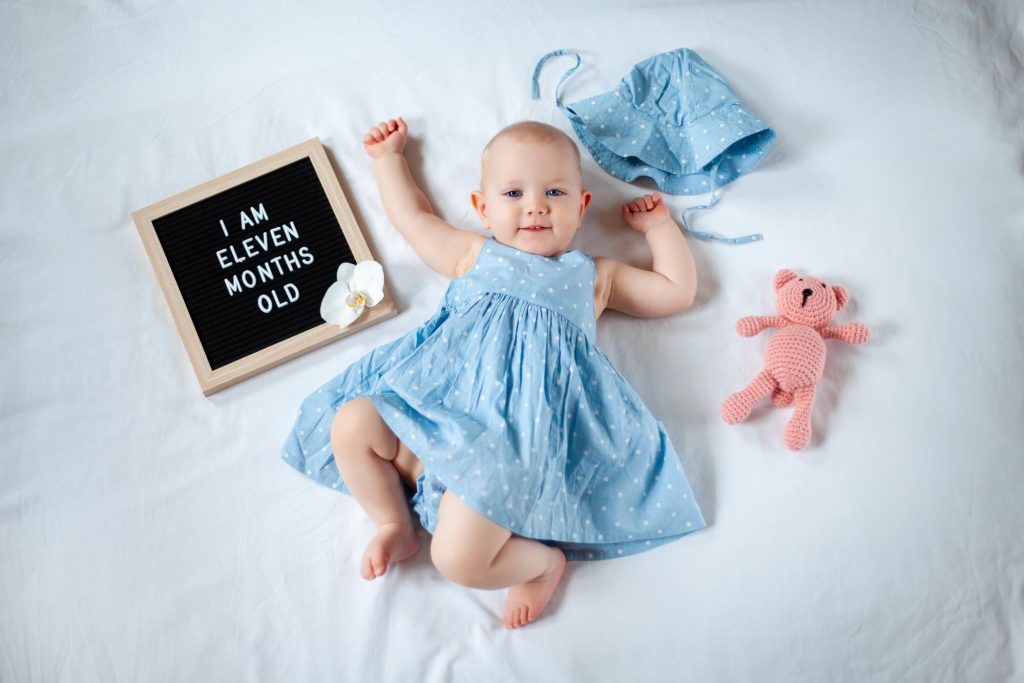
Lifting Objects
Place a toy in front of a child. The child should bend forward and squats, grabs a toy, and rises, and straightens again. Help the baby to rise first – offer him a hand.
Stacking Objects on Top of Each Other
Give the child the same size cubes to stack them on top of each other. If the baby succeeds, praise him. At the end of the first year of life, a skilled child is able to build a turret of more than two cubes. Later, let the child work with large cubes, then with smaller ones.
Stringing
This month is a good time to teach a child to put on different rings on a stick – whether made of plastic or metal. You can also use curtain rings. Or buy a toy suitable for this game directly.
💡 TIP N.5: The best toys suitable for baby‘s development
Doodling on Paper
First, show the child how to scribble with a crayon on a piece of paper – place the paper best on the floor, but a children’s chair with a built-in table is also suitable – so the child can scribble, the parent has free hands and can draw with the child. You can also combine this game with a game of learning about the colors of crayons.
Speech Development
The parent should take advantage of every situation and talk with the child. During the walk you can talk about, for example, what is happening in the area, at home you can talk about the plan for the coming day, etc.
12th Month of a Baby’s Life
If the child has already taken the first steps, try to get used the baby to walk in different conditions than just on a flat floor – sidewalk grass, sand, snow, etc.

Pushing Toys in Front
The task of pushing the toy in front of is to automate the child’s walk. By pushing the toy, the child pays attention to the toy, not to the walking. It also helps baby to orient himself when walking, even if his attention is focused on something else.
Pulling Toys Behind
Once the child has mastered the game of “pushing in front”, it is time to make the game more difficult in the opposite direction. Pulling a toy is an important exercise by turning backwards to the toy, the child has a difficult orientation. The child is used to going where he is looking or looking where he is going. In this case baby is looking in the opposite direction.
Pulling Objects
Keep a toy tied to a string, the end of tied put close to the baby’s hand, but out of the reach of the child. The child already knows or will quickly learn that he can pull the toy.
Even though this month is the last, it does not mean that the child’s development is over, quite the opposite. Now is the time to repeat all the games we have introduced to you and thus deepen the child’s abilities and skills – help with the development.
Signs When It’s Time to Play
Signs your little one is sending that indicate when it’s time to play:
- Watching you or other people with interest
- Reaching out for you
- Smiling
Signs When It’s Time for a Break
It’s also important to recognize signs when your infant has had enough of play time and needs a break:
- Crying
- Spitting up
- Looking away
The baby is very curious, creative and wants to learn new things. Everything attracts and interests him. This human desire to know and gain new experiences and skills will, of course, develop further. And it is up to parents to support and deepen this interest, effort and creativity.
In addition to details about the development of the baby, our overview of what happens in the first 12 months of a baby‘s life offers a lot of ideas for activities with your newborn. You will also find a lot of great activities with which you can support the development of your baby, and you’ll find information about toys suitable for individual baby’s development periods.
- Baby’s Development – 1st Month
- Baby’s Development – 2nd Month
- Baby’s Development – 3rd Month
- Baby’s Development – 4th Month
- Baby’s Development – 5th Month
- Baby’s Development – 6th Month
- Baby’s Development – 7th Month
- Baby’s Development – 8th Month
- Baby’s Development – 9th Month
- Baby’s Development – 10th Month
- Baby’s Development – 11th Month
- Baby’s Development – 12th Month
Final Tip: Helping Developmental Milestones with Annie Baby Monitor
Planning to play games for baby development to help your baby develop correctly?
Don’t forget to use the Annie Baby Monitor with its baby tracker feature. It’s super helpful to keep track of how your baby is growing, sleeping, and eating, supporting proper development.
The Annie Baby Monitor is a great helper that helps you make sure your baby grows right, faster, and better. Plus, it’s not just a baby tracker – it’s also a baby monitor.
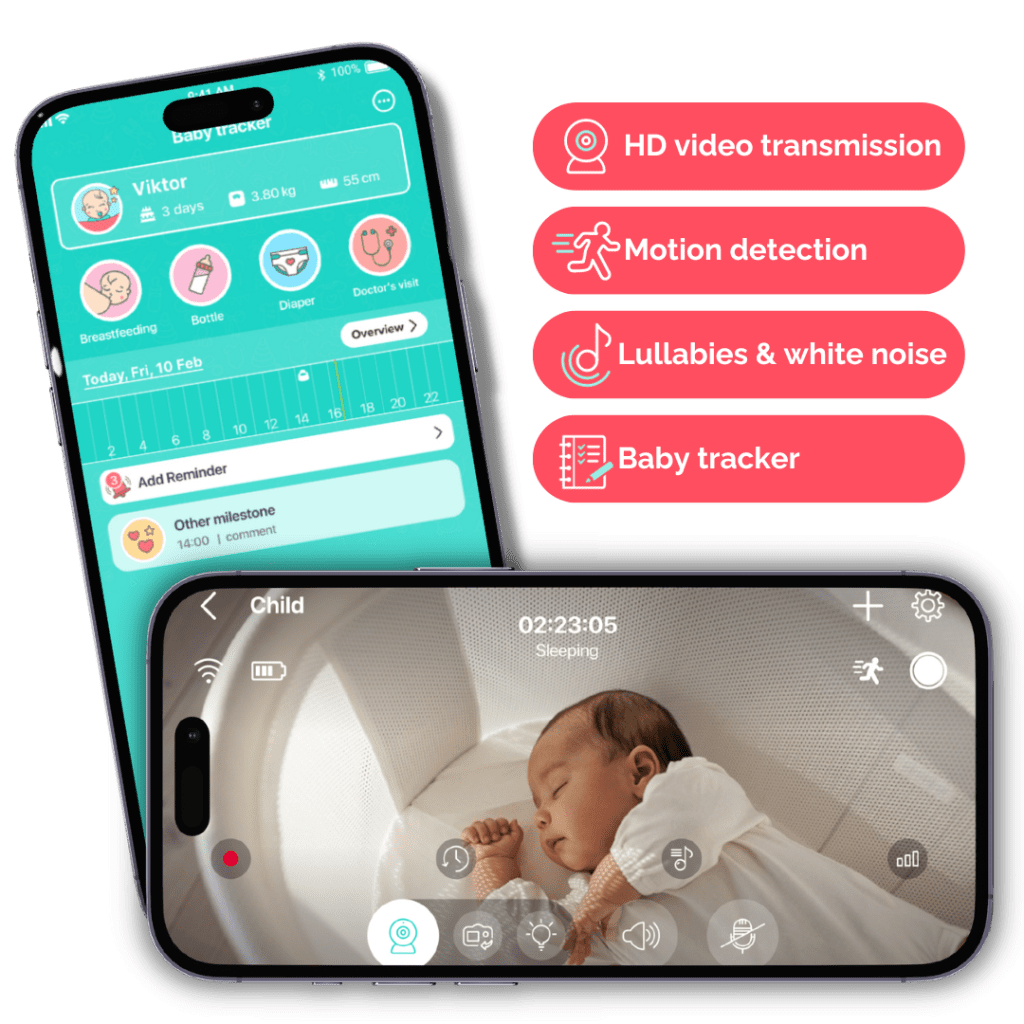
Looking for a top-notch parenting helper? Look no further than Annie Baby Monitor. It’s the perfect solution for keeping tabs on your little one. Check it out now.




